Koi Health
White Spot
Symptom: Fine white spots on body, fins and tail
The Koi most likely has a disease called White Spot, which looks like fine white spots on the body, fins and tail of the fish (like grains of salt). In severe cases, there may be excessive mucus and depressed fins and tail. Under the microscope the large round adult parasites have a distinctive pale horseshoe shaped nucleus. Adult parasites breed on the bottom of the pond and release large numbers of "swarmer cells" which swim around looking for fish to infect.
Not to be confused with:
Carp Pox
Breeding tubercles which occur only on the gill covers in spring.
If your Koi looks like the illustration, we recommend you use one of the products listed to help restore your fish to good health.
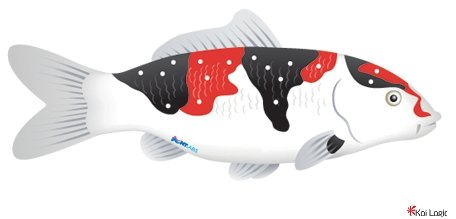
Fungal Disease
Symptom: Fluffy white growths on skin surface
The Koi most likely has a fungal disease, which looks like fluffy white cotton wool-like growths on flanks or wherever the skin has been damaged. It can sometimes have a green tinge when algae are also present in the water.
Not to be confused with:
Columnaris disease (cotton mouth) often seen as mouth rot and also around the edges of scales and fins causing the tissue to rot away.
If your Koi looks like the illustration, we recommend you use one of the products listed to help restore your fish to good health.
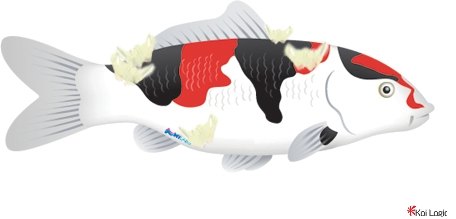
Bacterial Infection
Symptom: Ulcers or Sores on body, fins/tail rotting
The Koi most likely has a Bacterial Infection, which can cause a number of complaints. Your fish may have Ulcers/sores on their body and the tail, mouth and fins may have rotted away.
If your Koi looks like the illustration, we recommend you use one of the products listed to help restore your fish to good health.
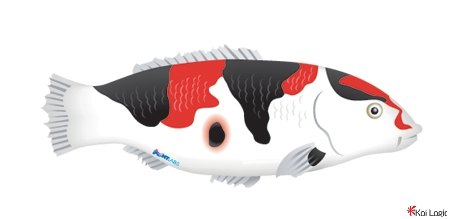
Septicaemia - Bacterial or Viral
Symptom: Gasping and clamped fins
The Koi most likely has bacterial or viral septicaemia, which is an internal infection. Physical signs could be: gasping, an excessive musus build up on skin, clamped fins with red veins, cloudy eyes, raised scales. Red haemorrhages at base of fins and around anus. Gill flukes could also cause some of these symptoms. A microscope examination is required to check for flukes. Virus infections can lead to many deaths over a short period of time (a few days) sometimes without showing many symptoms at all.
Internal bacterial infections are best treated with antibiotics either on food, if the fish are still feeding, or by injection. Antibiotics are only available on prescription from a veterinary surgeon.
Virus infections do not respond to antibiotic treatment. Support of the immune system to help the fish fight off the infection is the only practical help you can give.
If your Koi looks like the illustration, we recommend you use one of the products listed to help restore your fish to good health.
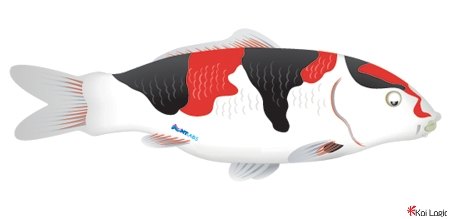
Viral Tumors
Symptom: Hard jelly lumps on skin surface (no picture available, contact us if you suspect your Koi is suffering from this)
The Koi most likely has viral Tumours, which look like jelly-like lumps all over body, often looking a bit like fingers (papilloma).
There is no specific treatment for these growths which often go away after some time. Supporting the immune system with good nutrition and good quality water will help the fish to recover.
Carp Pox
Symptom: Hard round lumps on fish
The Koi most likely has Carp Pox, which look like hard, flat, round, white spots all over the body of the fish. Can be quite large (2-3 mm) but present in a variety of sizes. Fish is generally OK and feeds normally with their fins erect. There is no specific treatment and the spots will often go away after some time. Support the immune system with good nutrition and good water quality.
Not to be confused with:
White Spot
Breeding tubercles which occur only on the male gill covers in spring.
If your Koi looks like the illustration, we recommend you use one of the products listed to help restore your fish to good health.
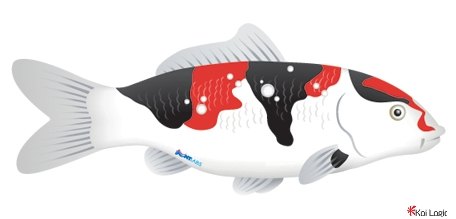
Dropsy
Symptom: Bulging eyes and scales sticking out
The Koi most likely has an internal bacterial infection called Dropsy.The body will appear swollen and scales will appear to stick out so that the fish looks like a pineapple. Eyes will be bulging and the fins drooping. Reddening at the base of the fins with red veins along fins and tail.
When fish have reached this stage of infection, they are often difficult to treat and may require antibiotics given by injection. Antibiotics can only be prescribed by a veterinary surgeon.
Not to be confused with:
Breeding female ready to spawn.
If your Koi looks like the illustration, we recommend you use one of the products listed to help restore your fish to good health.
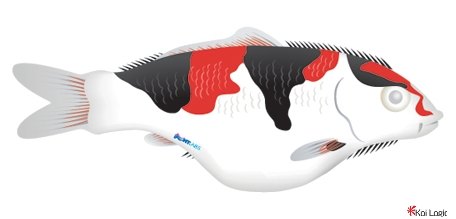
Ecto-parasitic Infection
Symptom: Small creatures hanging onto body
The Koi most likely has an ecto-parasitic infection, which could be Lice, Anchor Worms or Leeches. They are visible protruding parasites or worms that latch on to the body of the fish causing damage to skin.
If your Koi looks like the illustration, we recommend you use one of the products listed to help restore your fish to good health.
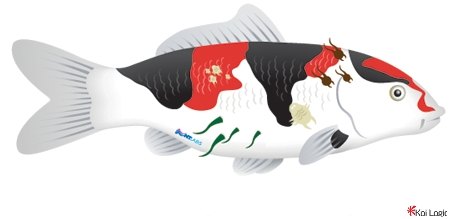
Flukes
Symptom: Flicking, droopy red veiny fins and gasping
The Koi most likely has Flukes, which are invisible to the naked eye unless looked at through a microscope. Visible signs of Flukes would be fish flicking and rubbing against rocks etc. Excessive mucus, drooping fins and tail, lethargic behaviour, sometimes gasping at water inlet, red veins on fins and tail.
If your Koi looks like the illustration, we recommend you use one of the products listed to help restore your fish to good health.
.jpg)
